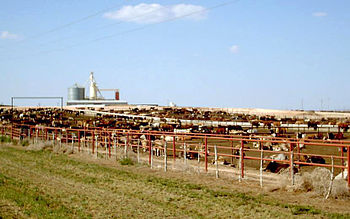This is an old revision of this page, as edited by IrishFBall32 (talk | contribs) at 13:17, 6 June 2007 (Reverted 1 edit by 74.60.17.97 to last revision by Joelmills. using TW). The present address (URL) is a permanent link to this revision, which may differ significantly from the current revision.
Revision as of 13:17, 6 June 2007 by IrishFBall32 (talk | contribs) (Reverted 1 edit by 74.60.17.97 to last revision by Joelmills. using TW)(diff) ← Previous revision | Latest revision (diff) | Newer revision → (diff)
A feedlot or feedyard is a type of concentrated animal feeding operation (CAFO) (also known as "factory farming") which is used for finishing livestock, notably beef cattle, prior to slaughter. They may contain thousands of animals in an array of pens. Most feedlots require some type of governmental permit and must have plans in place to deal with the large amount of waste that is generated. Long-running feedlots are often exempt due to various "grandfather clauses", which allow feedlots to wait until a change of ownership before obtaining permits and designing formal waste management plans.
Prior to entering a feedlot, cattle spend most of their life grazing on rangeland or on immature fields of grain such as wheat pasture. Once cattle obtain an entry-level weight, about 650 pounds (300 kg), they are transferred to a feedlot to be fed a specialized diet which may be made up of hay, corn, sorghum, various other grains, by-products of food processing, such as sugar beet waste, molasses, soybean meal, or cottonseed meal, and minerals. In the American northwest and Canada, barley, low grade durum wheat, chick peas (garbanzo beans), oats and occasionally potatoes are used as feed.
Feedlot diets are usually very dense in food energy, to encourage the deposition of fat, or marbling, in the animal's muscles; this fat is desirable as it leads to 'juiciness' in the resulting meat. The animal may gain an additional 400 pounds (180 kg) during its 3-4 months in the feedlot
Aside from ethical and environmental concerns, feedlots have come under criticism for human health reasons. The tissues of feedlot-raised cattle have far more saturated fat than that of grass-fed cattle, some sources say up to 500 percent more. Feedlot-raised beef may after long periods on feed have reduced healthy omega-3 fatty acids because of the corn-and-grain diets of the cattle.
Once cattle are fattened up to their finished weight, the cattle are transported to a slaughterhouse.
See also
Reference
- Harris Ranch Beef Company. "Harris Ranch Feedlot...Beef the Way Nature Intended It to Be!" Company official site, accessed September 1, 2006
- Hyman, MD, Mark, Ultrametabolism: The Simple Plan for Automatic Weightloss, Scribner (2006), pp.35-36.
- www.grassrootsbeef.com
External links
- Texas Cattle Feeders Association
- Harris Feeding Company, California's largest cattle feeder
- Clean Water and Factory Farms - Inhumane Treatment of Farm Animals
- Australian Lot Feeders Association